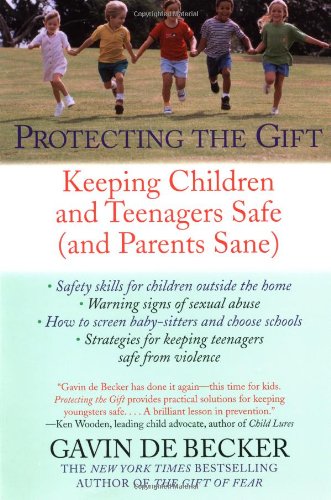
Safety skills for children outside the home
Warning signs of sexual abuse
How to screen baby-sitters and choose schools
Strategies for keeping teenagers safe from violence
All parents face the same challenges when it comes to their children’s safety: whom to trust, whom to distrust, what to believe, what to doubt, what to fear, and what not to fear. In this empowering book, Gavin de Becker, the nation’s leading expert on predicting violent behavior and author of the monumental




















Don’t Procrastinate!,
I hate reading anything that makes me feel anxious and initially this book sat on the shelf for weeks before I actually picked it up. I was so glad I did because there is such valuable information in here and I actually feel better about my child’s safety than I did before.
Protecting the Gift: Keeping Children and Teenagers Safe and Parents Sane is about how to teach your child to trust her instincts when it comes to safety. Since 90{660353129f8d892044c993645a1c75194301fec6786a7f617c15adde0b0011e9} of child abuse and abductions occur by people well-known to your child, teaching her to talk to strangers just doesn’t work. Instead, the author gives you detailed and logical steps to take, starting as early as toddlerhood, so you’ll know how to help your child learn to follow her instincive feelings about whether someone is safe or not.
Crucial information about how to be prepared for (God forbid but we should all be prepared just in case) the event that your child may be seperated from you in public. Examples include making a daily detailed mental note of the clothing your child is wearing, keeping large photocopies of your child’s picture and name in your purse/wallet so you can hand them out to security personel within seconds of your child’s disappearance and an action plan for immediate implementation.
There is SO much in this book – every bit of it worth reading so you can protect your child – and I can’t recommend it strongly enough. Read it NOW and be prepared.
Was this review helpful to you?

|If you care about kids, you should read this book!,
Gavin De Becker’s new book is a valuable and important extension of his excellent “The Gift of Fear.” I teach high school psychology and had my classes read TGOF, which proved to be an eye-opening, empowering tool for teenagers. “Protecting the Gift” expands on these ideas by specifically focusing on child and teenager safety. While I agree with some minor criticisms that the new book repeats some older material, the repeated material is worth hearing again, and the new book provides the most thoughtful and specific advice I have heard on how to talk to children about self-protection. As I new parent, I am grateful for De Becker’s instructions. My own parents are wonderful, but as I suspect is true of the vast majority of families, they never talked to me as a child about how to recognize, prevent, and report sexual abuse–or how to trust my intuition and say no to adults in any number of questionable circumstances. By teaching us how to engage in this dialogue, De Becker is doing the public a great service!
Was this review helpful to you?

|Buy it for yourself and those who take care of your child,
While expecting our first baby and then as new parents, my wife and I received loads of excellent advice from friends and family regarding childbirth, doctors, baby-care, day-care, formula brands, etc. Last week, as a father with 8 weeks of experience in parenting, I had my first opportunity to offer advice to an expectant parent. I suggested she visit two day care centers I had liked, visit the pediatrician my wife and I chose, and read Protecting the Gift by Gavin de Becker.
Gavin de Becker makes his living predicting and preventing violent behavior. His firm provides security and consultation to celebrities, athletes, world leaders, the CIA, U. S. Supreme Court and other security organizations around the world.
In Protecting the Gift, de Becker introduces parents to startling statistics revealing the violent reality of our culture: one in four girls and one in six boys will be sexually molested by the time they reach adulthood; 90 percent of sexual abuse is committed by someone the child knows; the most common age that sexual abuse begins is when the child is three years old. Most parents live with a mindset that denies or ignores this reality. But as de Becker shows in his book, our children are living in this reality everyday.
De Becker’s purpose in this book is two-fold: 1) to hit parents in the face with the real dangers awaiting children, and 2) to teach parents how to avoid fruitless worry and to take meaningful steps to protect children. On both points, de Becker succeeds.
Parents are raising children during an age when an FBI child-pornography sting indicts teachers, coaches, pastors and judges. It is an age of guns and date-rape drugs. At the same time, many parents experience an urgent need for help in raising children, often from the age of six-weeks onward. Parents look for family, day care workers, sitters, schools, nannies and friends to provide support in raising children. How can parents assure their children’s safety?
De Becker addresses this question by first focusing on the fact that violent behavior can be predicted. The book teaches that children can be taught skills to avoid dangerous situations and people. He emphasizes the development and use of intuition as a parent’s key resource in recognizing threats. He cites numerous stories of people avoiding harm by listening to intuition and others who ignored intuition and became victims.
De Becker shares many practical lessons. He teaches what to look for in safe child-care workers and sitters. He lists the signs that indicate a dangerous stranger versus a friendly stranger. He also illustrates ways that well-meaning parents do things that increase a child’s vulnerabilities.
The Bible teaches that wolves dress in sheep’s clothing and that evil-doers masquerade as angels of light. Nothing fits this description more precisely than a sexual predator of children. De Becker teaches that pedophiles and rapists often gain the confidence of their victims through being overly “nice” and “helpful.” They have to do this. How else can a pedophile convince parents to trust him or her with their children. Over and over, we see that pedophiles go to where they can have access to children and, like chameleons, blend in perfectly.
I think people in the church today are especially susceptible to this type of criminal, because the presence of evil has been downplayed and we are usually willing to give people the benefit of the doubt and accept them at face-value. De Becker shows parents how to remove doubt and to know who can and cannot be trusted.
There are several other topics in this book that I think are important to parents. The book cover summarizes one of de Becker’s purposes in writing it: “By showing what danger really looks like-as opposed to what we might imagine it looks like-de Becker gives parents freedom from many common worries and unwarranted fears.”
A lasting impression I take from the book is that the people with whom I and my family interact are who they are not who I want them to be. I know that some people are influenced by perverse and evil desires aimed at children. Because of this truth, I think it is important that parents read this book. I also suggest that adults, especially women, read de Becker’s bestseller The Gift of Fear.
Craig Stephans, author of Shakespeare On Spirituality: Life-Changing Wisdom from Shakespeare’s Plays
Was this review helpful to you?

|